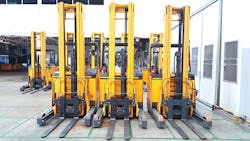Businesses will find positive momentum for equipment investment as the changing economic and regulatory environment contributes to improved business conditions, according to the Equipment Leasing and Finance Association (ELFA).
The group points out that U.S. businesses, nonprofits and government agencies will spend over $1.5 trillion in capital goods or fixed business investment (including software) this year. Consequently financing a majority of those assets, will impact a significant portion of the U.S. economy.
“Equipment acquisition continues to drive the supply chains across all U.S. manufacturing and service sectors,” said Ralph Petta, CEO of ELFA.
So the group released its Top 10 Equipment Acquisition Trends for 2017, to “assist businesses in understanding the marketplace and planning their acquisition strategies.”
ELFA forecasts the following:
Look for capital spending to pick up in 2017 after the previous year’s negative equipment and software investment growth.
After overall negative growth in 2016, equipment and software investment is on track to improve in 2017. Renewed enthusiasm by business owners to make capital investments will be driven by solid employment rates, rising incomes and higher business confidence.
Expect growth of financed equipment acquisitions to outpace growth in total equipment investment.
Growth in equipment and software investment this year will be exceeded by growth in equipment financing as the propensity to finance has increased. A reduced rate of cash outlays, a greater percentage of firms financing—nearly 8 in 10 businesses—and an increase in the rate of lease financing, along with market data indicating that the equipment leasing and finance industry is emerging from a period of slow growth, all point to higher investment in 2017.
More business-friendly federal policy will bolster business investment and economic growth.
Businesses will be further induced to make capital investments with promised action from the new Trump Administration and Congress for infrastructure spending, tax relief and reduced regulatory burdens and other constraints. These fiscal and regulatory policies will contribute to moderately strong growth for the U.S. economy, and somewhat higher growth for equipment and software investment in 2017. However, a tempering influence to this growth scenario is the potential curtailing or elimination of interest deductibility as part of congressional efforts to reform the tax code.
Changes in trade policy will risk headwinds for equipment exports.
Businesses will also be following developments from the Trump Administration for a less-friendly trade environment. The potential for exiting the Trans-Pacific Partnership (TPP), renegotiating or withdrawing from the North American Free Trade Agreement (NAFTA), and striking a sterner stance with China could spur retaliation from trading partners that will hinder exports and greater economic growth.
The oil industry drag on the U.S. economy will cease.
The oil price freefall that sent oilfield and mining investment plunging has steadied. With sector spending showing positive growth after two years and the prospect of a friendlier regulatory environment, expect increased oil industry production and investment.
Many key equipment verticals will benefit from positive momentum. Changes in market and economic conditions will be good news for a number of previously underperforming equipment verticals this year. Stabilizing oil prices will positively impact not only oilfield and mining investment, but also railroad, materials handling and industrial equipment. Look for increased construction equipment investment due to improving personal consumption and promised infrastructure spending.
Businesses will need to keep abreast of interest rate increases. A non-issue since the Great Recession, expect additional rate increases this year after the December 2016 hike. Businesses will need to assess and plan for financing options accordingly as the Fed acts to keep inflation in check.
Innovations in the equipment finance industry will increase flexibility and convenience for customers. End-users seeking value-added benefits for ease of access and process improvements will find them when financing equipment this year. The availability of “fintech” as an alternative method of financing, managed solution transactions to realize the benefits of aligning costs with business demands and avoid obligations of ownership, and e-chattel for efficient paperless transactions are just a few of the growing trends to watch in equipment finance this year.
Lease accounting changes won’t deter financed equipment acquisitions. Changes approved by the Financial Accounting Standards Board (FASB) in 2016 to bring leases on-balance sheet weren’t as burdensome as many had anticipated, and the primary reasons to lease remain intact under the new rules. This year will see organizations preparing in earnest for the new standard to take effect beginning in 2019.
Businesses will watch for potential “wild cards” when considering equipment acquisition decisions.
Despite many favorable factors for equipment spending this year, U.S. businesses will be keeping an eye on developments on numerous fronts. The impacts of geopolitical shifts such as the U.K.’s Brexit move and the prominence of the National Front in France and other groups that are contrary to the existing liberal, free-market international order could be disruptive financially, politically and even militarily. Also, the new Administration’s promised infrastructure spending will depend on the size, design and level of political support of budget-conscious Republicans to pass. Finally, the unknown and long-term economic implications of terrorism continue to loom.
